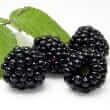Background
- Blackberry is a rambling vine with thumb-sized black composite "berries." The plant grows easily in temperate climates, and is often found in recently cleared areas. Laboratory studies have found blackberries to be high in antioxidants, although no benefits were observed in one clinical trial. More research is needed in this area before a potential therapeutic recommendation can be made.
- Because of the tannins in the blackberry plant's root bark and leaves, blackberry has been used as an astringent and tonic, and for dysentery (severe diarrhea) and diarrhea. A tea of the root bark has also been used for whooping cough.
References
Natural Standard developed the above evidence-based information based on a thorough systematic review of the available scientific articles. For comprehensive information about alternative and complementary therapies on the professional level, go to . Selected references are listed below.
- Armentia A, Barber D, Lombardero M, et al. Anaphylaxis associated with antiphospholipid syndrome. Ann Allergy Asthma Immunol 2001;87(1):54-59.
View Abstract - Blomhoff R. [Antioxidants and oxidative stress]. Tidsskr Nor Laegeforen 6-17-2004;124(12):1643-1645.
View Abstract - Carmen Ramirez-Tortosa M, Garcia-Alonso J, Luisa Vidal-Guevara M, et al. Oxidative stress status in an institutionalised elderly group after the intake of a phenolic-rich dessert. Br J Nutr 2004;91(6):943-950.
View Abstract - Ding M, Feng R, Wang SY, et al. Cyanidin-3-glucoside, a natural product derived from blackberry, exhibits chemopreventive and chemotherapeutic activity. J Biol Chem 6-23-2006;281(25):17359-17368.
View Abstract - Felgines C, Talavera S, Texier O, et al. Blackberry anthocyanins are mainly recovered from urine as methylated and glucuronidated conjugates in humans. J Agric.Food Chem 10-5-2005;53(20):7721-7727.
View Abstract - Feng R, Bowman LL, Lu Y, et al. Blackberry extracts inhibit activating protein 1 activation and cell transformation by perturbing the mitogenic signaling pathway. Nutr Cancer 2004;50(1):80-89.
View Abstract - Halvorsen BL, Holte K, Myhrstad MC, et al. A systematic screening of total antioxidants in dietary plants. J Nutr 2002;132(3):461-471.
View Abstract - Netzel M, Strass G, Janssen M, et al. Bioactive anthocyanins detected in human urine after ingestion of blackcurrant juice. J Environ.Pathol Toxicol Oncol 2001;20(2):89-95.
View Abstract - Pellegrini N, Serafini M, Colombi B, et al. Total antioxidant capacity of plant foods, beverages and oils consumed in Italy assessed by three different in vitro assays. J Nutr 2003;133(9):2812-2819.
View Abstract - Serraino I, Dugo L, Dugo P, et al. Protective effects of cyanidin-3-O-glucoside from blackberry extract against peroxynitrite-induced endothelial dysfunction and vascular failure. Life Sci. 7-18-2003;73(9):1097-1114.
View Abstract - Tournas VH, Katsoudas E. Mould and yeast flora in fresh berries, grapes and citrus fruits. Int J Food Microbiol. 11-15-2005;105(1):11-17.
View Abstract - Wang Y, Finn C, Qian MC. Impact of growing environment on chickasaw blackberry (Rubus L.) aroma evaluated by gas chromatography olfactometry dilution analysis. J Agric.Food Chem 5-4-2005;53(9):3563-3571.
View Abstract - Yang DJ, Krishnan RS, Guillen DR, et al. Disseminated sporotrichosis mimicking sarcoidosis. Int J Dermatol 2006;45(4):450-453.
View Abstract







